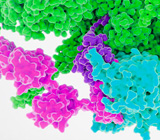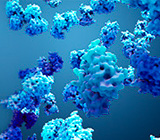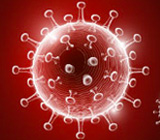-
REAGENT SERVICES
Hot!
-
Most Popular Services
-
Molecular Biology
-
Recombinant Antibody/Protein
-
Reagent Antibody
-
CRISPR Gene Editing
-
DNA Mutant Library
-
IVT RNA and LNP Formulations
-
Oligo Synthesis
-
Peptides
-
Cell Engineering
-
- CRISPR/Cas9 sgRNA
- CRISPR/Cas12a crRNA
- Prime Editing Guide RNA
- Base Editing Guide RNA
- HDR Templates
- gRNA + HDR Template Design Tools
- cGMP Guide RNA
- cGMP HDR Templates
- CRISPR/Cas Proteins
- CAR-T Knock-in Optimization Kit
- CRISPR Plasmids
- CRISPR gRNA Plasmid Libraries
- CRISPR Cell Lines
- Microbial Genome Editing
-
-
PRODUCTS
-
Most Popular Reagents
-
 Instruments
Instruments
-
Antibodies
-
ELISA Kits
-
Protein Electrophoresis and Blotting
-
Protein and Antibody Purification
-
Recombinant Proteins
-
Molecular Biology
-
Stable Cell Lines
-
Cell Isolation and Activation
-
 IVD Raw Materials
IVD Raw Materials
-
 Therapy Applications
Therapy Applications
-
Resources
-
- Pharmacokinetics and Immunogenecity ELISA Kits
- Viral Titration QC ELISA Kits
- -- Lentivirus Titer p24 ELISA KitHot!
- -- MuLV Titer p30 ELISA KitNew!
- -- AAV2 and AAVX Titer Capsid ELISA Kits
- Impurity Test ELISA Kits
- -- BSA ELISA Kit, 2G
- -- Cas9 ELISA KitNew!
- -- Protein A ELISA KitNew!
- -- His tagged protein detection & purification
- -- dsRNA ELISA Kit
- -- Endonuclease ELISA Kit
- COVID-19 Detection cPass™ Technology Kits
-
- Automated Maxi-Plasmid PurificationHot!
- Automated Mini-Plasmid PurificationNew!
- PCR Reagents
- S.marcescens Nuclease Benz-Neburase™
- DNA Assembly GenBuilder™
- Cas9 / Cas12a / Cas13a Nucleases
- Base and Prime Editing Nucleases
- GMP Cas9 Nucleases
- CRISPR sgRNA Synthesis
- HDR Knock-in Template
- CRISPR Gene Editing Kits and Antibodies
-
![AmMag™ Quatro Automated Plasmid Purification]() AmMag™ Quatro automated plasmid purification
AmMag™ Quatro automated plasmid purification
-
![Anti-Camelid VHH]() MonoRab™ Anti-VHH Antibodies
MonoRab™ Anti-VHH Antibodies
-
![ELISA Kits]() ELISA Kits
ELISA Kits
-
![Precast Gels]() SurePAGE™ Precast Gels
SurePAGE™ Precast Gels
-
![Quatro ProAb Automated Protein and Antibody Purification System]() AmMag™ Quatro ProAb Automated Protein and Antibody Purification System
AmMag™ Quatro ProAb Automated Protein and Antibody Purification System
-
![Target Proteins]() Target Proteins
Target Proteins
-
![AmMag™ Quatro Automated Plasmid Purification]() AmMag™ Quatro automated plasmid purification
AmMag™ Quatro automated plasmid purification
-
![Stable Cell Lines]() Stable Cell Lines
Stable Cell Lines
-
![Cell Isolation and Activation]() Cell Isolation and Activation
Cell Isolation and Activation
-
 IVD Raw Materials
IVD Raw Materials
-
![Quick
Order]() Quick Order
Quick Order
-
![Quick
Order]() Quick Order
Quick Order
- APPLICATIONS
- RESOURCES
- ABOUT US
- SIGN IN My Account SIGN OUT
- REGISTER

![Amino Acid Code Amino Acid Code]()
Biology Terms Dictionary
This Biology terms dictionary provides query services for biology and biochemistry terms. Please enter the biology or biochemistry terms you want to search.
List by Alphabet: A B C D E F G H I J K L M N O P Q R S T U V W X Y Z
CHO cell
Introduction
Chinese Hamster Ovary (CHO) cells are a widely used mammalian cell line in biotechnology and pharmaceutical industries. These cells were first isolated from the ovary of the Chinese hamster (Cricetulus griseus) in the 1950s and have since been adapted for large-scale production of therapeutic proteins. CHO cells are the preferred host for producing recombinant proteins, monoclonal antibodies, and biosimilars due to their ability to perform post-translational modifications, particularly glycosylation, which is crucial for maintaining the stability and efficacy of therapeutic proteins.
Characteristics of CHO Cells
1. Adaptability and Scalability
CHO cells can adapt to growth in both adherent and suspension cultures, which makes them highly suitable for scaling up in industrial bioreactors. In suspension, they can be grown to high densities, optimizing production efficiency for biopharmaceutical manufacturing. 2. Post-Translational Modifications
CHO cells perform human-like glycosylation, ensuring that recombinant proteins, particularly antibodies, maintain appropriate structure and function. These modifications improve protein stability, bioactivity, and pharmacokinetics, making CHO-derived products viable for clinical applications.
3. Genetic Stability
CHO cells can stably integrate transgenes, allowing for the creation of stable cell lines that express recombinant proteins consistently over time. This makes them a reliable choice for long-term commercial production of biologics.
4. Resistance to Viral Infection
Compared to other mammalian cell lines, CHO cells exhibit low susceptibility to viral infections, enhancing the safety of pharmaceutical production. This is one reason regulators favor CHO-based systems for biologics manufacturing.
Mechanisms of CHO Cell Utilization
1. Stable vs. Transient Transfection
• Stable Transfection: DNA encoding the target protein is integrated into the CHO cell genome, creating a cell line that can express the protein consistently over many generations. This is ideal for large-scale production.
• Transient Transfection: DNA is introduced temporarily, leading to short-term protein expression. Transient expression is used for rapid protein production in early-stage research but is less efficient for commercial manufacturing.
2. Fed-Batch and Perfusion Cultures
• Fed-Batch: Nutrients are added at intervals during the production process, extending the productivity of the culture. This is a common method for CHO-based antibody production.
• Perfusion: The medium is continuously refreshed, and waste is removed. Perfusion systems allow for extended production cycles but are more complex and costly to operate.
3. Cell Line Engineering
Genetic modifications can improve CHO cell productivity by:
• Enhancing growth rates and cell viability.
• Modifying glycosylation pathways to produce consistent therapeutic protein.
• Reducing lactate accumulation, which can impair cell growth and protein expression.
Applications of CHO Cells
1. Therapeutic Protein Production
CHO cells are the leading platform for producing monoclonal antibodies (mAbs) and other therapeutic proteins, such as erythropoietin (EPO) and coagulation factors.
2. Biosimilars
The versatility of CHO cells makes them ideal for producing biosimilars—affordable alternatives to original biologics—without compromising on quality.
3. Vaccine Development
CHO cells are also used for vaccine production, especially for subunit vaccines, due to their ability to express complex proteins with high fidelity.
4. Diagnostics
CHO cells are employed in the development of diagnostic tools, such as enzyme-linked immunosorbent assays (ELISA) and immunoassays, for detecting biomarkers in clinical settings.
GenScript Solutions for CHO Cell Applications
GenScript provides a suite of products and services to optimize CHO cell-based workflows:
• TurboCHO™ Stable Cell Line Development: Accelerates the creation of high-yield stable cell lines.
• Custom Culture Media: Tailored formulations to improve CHO cell growth and protein expression.
• Antibody Purification Tools: Resins and purification kits for efficient recovery of high-quality proteins.
• Gene Synthesis and Vector Construction: Optimized vectors to enhance transfection efficiency and expression levels.
These services streamline the production process, ensuring high yields and consistent product quality for commercial-scale biologics production.
Conclusion
CHO cells play an essential role in the production of therapeutic proteins, particularly monoclonal antibodies. Their ability to perform complex post-translational modifications, maintain genetic stability, and grow in scalable culture systems makes them a preferred platform for biologics manufacturing. Continuous advancements in cell line engineering, media optimization, and bioreactor technologies will further enhance CHO cell applications, meeting the growing demand for safe, effective, and affordable therapeutics.
- Tags:
- Protein
Related Biology Tools
-
GenSmart™ Codon Optimization
GenSmart Optimization is a free online tool for performing codon optimization to improve gene expression. GenScript's patented algorithms are integrated into the tool to optimize the computing capability of high-performance sequence generation.
-
DNA Construct Design Tool
GenSmart™ Design is a free online DNA construct design tool developed by GenScript. GenSmart™ Design has two design modules, the Create Construct module for individual plasmid design and the Create Library module for DNA library design.
-
Codon Frequency Tables
This online tool shows commonly used genetic codon frequency table in expression host organisms including Escherichia coli and other common host organisms.
Service and Products

Protein Expression
GenScript recombinant protein and rAb services provide high quality recombinant proteins and rAbs for a variety of downstream research applications.

Bacterial Expression
One-stop service from Sequence to Protein starting from $1600, 4 weeks.

Insect Expression
GenScript's BacuVance baculovirus expression system was developed by our in-house team of scientists for virus production and expression of recombinant proteins from baculovirus-infected insect cells.

Mammalian Transient Expression
Proprietary High Density (HD) expression system, enhance the protein yield up to 100 fold, achieve antibody titers up to 3 g/L.

Reagents for COVID-19 Research
Gram level, ready to ship RBD proteins, ACE2 assay cell lines and pseudovirus.
-
Top Search
-
Hot Glossary
-
Antibody
If you know of any terms that have been omitted from this glossary that you feel would be useful to include, please send detail to the Editorial Office at GenScript: website@genscript.com
If your term is adopted, we will send 1,000 EzCoupon points to your GenScript account.
-





































